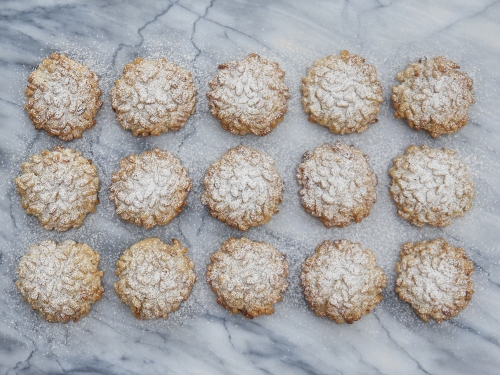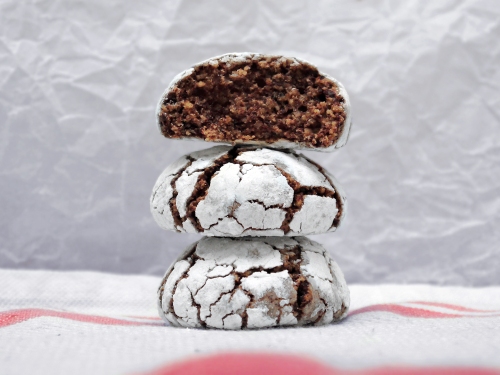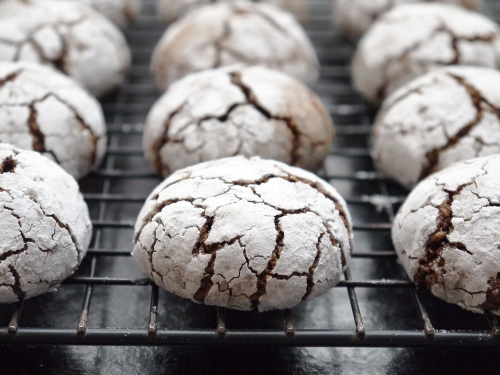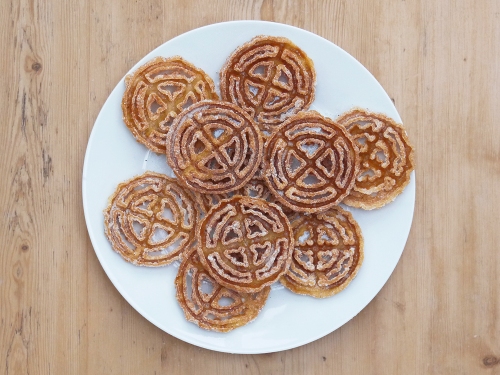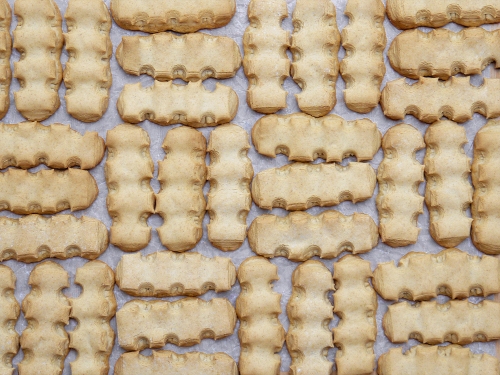My previous festive baking post offered simplicity, so it was only inevitable that today we’d go back to complexity. And as it is New Year’s Eve, albeit the low-cal and less exciting version, it is only fitting that we do something that is colourful and has a bit of panache to it.
Earlier in this year’s baking extravaganza I posted some cookies from the Philippines and mused that I had not made many recipes from outside of the gingerbread-spice world of Western Europe. Then I got a suggestion from a helpful reader, Jamie, who suggested I have a go at Italian Rainbow Cookies. In spite of the name, they are a staple of American Christmas baking, particularly amoung the Italian-American community, so would tick the box of stepping beyond Europe for holiday inspiration. So…I did just that. I did actually have another recipe in mind for the No 11 slot this year, but for better or worse it has been bumped. Maybe it will make the cut for the 2021 edition?
Truth be told, I’ve seen these before, but I’ve been put off from making them as they look complicated. However what with lockdowns and the like, I’ve got plenty of time on my hands (i.e. my excuse has gone), so we were all set for some lurid rainbow cookies. All fabulous seven layers of them. And here is what I made!

I’m beyond thrilled with how they worked out. Seeing them all laid out neatly like this I have the vague feeling that I’ve made some sort of edible interactive Tetris set. I originally arranged them in neat lines all in the same way but it looked too orderly. Hence the more random arrangement. It’s chaos within order.
These little guys are also called Seven-Layer Cookies, and it’s easy to see why. There are three layers of almond-flavoured sponge, sandwiched together with jam, and then the top and bottom have a layer of dark chocolate. They are made as one giant sheet, then cut into individual bite-sized cubes.
I find them both cute and oddly extravagant. But are they Italian? Are they a rainbow? And are they really cookies? The last two are easy. You could go with any colour you wanted, but the red/white/green tricolore seems to be pretty ubiquitous. The tricky thing is to get more of a rainbow, you need more layers, which makes them more complex, and the size would become impractical. I also think it is wise to go with colours that could be natural as opposed to blues and purples. So they’re not a real rainbow, but I think the three colours do work well together.
Are they cookies? Well, not in the sense of something that is made from dough that has been rolled out and shaped or cut. But neither are they cookies made from balls of dough, or drops of batter. While the term “cookie” is pretty flexible, these guys are really are more like little cakes. The closest I can think of are petit fours, those fancy little bite-sized French cakes you might get with afternoon tea or after a special dinner.
So, they’re at least Italian, right? This is where things get more mixed. Some think they’re not Italian at all, while others think they must have at least a tenuous link to the old country. Other sources suggest the recipe was developed within the Jewish community that lived alongside Italians in American cities. Whatever the true origin, they have acquired the “Italian” moniker and they seem to be a key part of an Italian nonna’s festive baking repertoire, and given that it’s probably best not to argue.
But where to start with baking them? Jaime pointed me in the direction of the Smitten Kitchen recipe from Deb Perelman. I’ve followed some of Deb’s recipes in the past, and been pleased with the results. In a pretty crowded online recipe world, and with what seem like dozens of YouTube videos of those nonnas making these things, I decided to go with a recipe that I was pretty confident would work. She also writes with candour about how she found the process and offers tips for getting it right, which is something I always like to see. A tricky recipe being described as “easy” or “a breeze” does no service to the reader and it underplays the work of the baker too.
I planned to do this over two days, as they baked cake part needs to chill for at least 8 hours with a weight on it. I think the idea is that this helps to ensure the cookies are perfectly flat, the layers bond to each other, and I think it helps with the texture too. I figured I could do all the baking and assembly one day, then do the chocolate and the chopping the next. I recommend doing it in this way as it helps keep you sane. The kitchen does end up covered in a fair few bowls coated in many different colours.
But was the whole process a breeze? I did have one major wobble. Once I’d done the baking, assembling and chilling, I removed the tray from the fridge to start doing the chocolate layers. I trimmed the sides, partly to neaten it all up, and partly to have some offcuts to eat. With a nice sharp knife it was a dream to cut. Then I was frankly horrified upon doing a sneaky taste – the cakes seems dry and hard. I panicked. Had they been over-baked? Had I wasted my time? In fact, they were just cold. As they came up to temperature, they softened and that delicious jammy almond flavour emerged. So yeah, just note that this happens!
The chocolate layer was the bit that worried me. You need to do the top and the bottom. Now, I can temper chocolate, but it takes time and patience. Plus it is about 1 degree (centigrade) outside, so our old London brick house is freezing which makes it all the more tricky to get chocolate to a precise temperature – not too hot, not too cold. This was a problem that the Smitten Kitchen recipe had too. Well, it turns out the answer was actually mercifully simple – you just add a little unsalted butter to the melted chocolate. No tempering, and this also means the chocolate has a bit of “give” so that it becomes easier to cut.

And what’s the verdict? Well this comes in two parts. How much work were they, and how do they taste.
In terms of effort, they are a lot less work than I thought. I probably spent one hour doing all the baking, and that was alongside keeping an eye on my son, who also tried to help (and promptly made a mess). Then maybe 20 minutes assembling it all before leaving to chill overnight. The chocolate was the job for the second day. Splitting it up in this way makes it quite easy. Manageable mess, and you don’t end up going doolally from it all. Italian Rainbow Cookies are also quite fun to make them if you’re slightly obsessive about precision in your baking. For indeed, my much-treasured Japanese steel metal ruler helped get those sharp lines and equal cuts.
In terms of how they taste, I love them. They have an intense almond flavour and lovely fruitiness from the jam (which I boosted with a little amaretto and some cherry liqueur). This is all balanced by the dark chocolate. I’d even go so far as to say that they taste much better than they look. While I’m all up for a bit of whimsy in the baking, the red/white/green colour scheme is a touch lurid for my tastes. But then, it is iconic, and I wonder if anything else really would do? Plus, where else are you going to find cookies that can symbolise the flags of Italy, Hungary, Ghana and Mali depending on how you place them? They are certainly some of the most striking things I’ve ever made in terms of the looks department.
So there we have it – my efforts in accepting one reader’s challenge. I’ll wrap up by sharing a tip of my own for recipes like this one where you have to divide the batter and the jam into equal portions. Get some electric scales, and weigh your bowls before using them. This makes it really easy to work out by weight how much batter or jam should be in each portion. I happen to know my main mixing bowl is 580g. Believe me, it saves a lot of guessing, eyeballing and general culinary angst. And it does help get even layers when making something like Italian Rainbow Cookies where you want to be precise to show off just how fancy you can get with your baking.
To make Italian Rainbow Cookies (recipe from Smitten Kitchen, with some tweaks)
For the batter
• 4 large eggs, separated
• 200g white caster sugar
• 200g almond paste (see note)
• 285g unsalted butter
• 1 teaspoon almond extract
• 1/2 teaspoon vanilla extract
• 260g plain flour
• 1/2 teaspoon baking powder
• 1/2 teaspoon salt
• red food colouring
• green food colouring
To fill
• 1 x 340g jar apricot jam
• 4 tablespoons water or amaretto and cherry liqueur (I used Luxardo Maraschino)
To finish
• 200g dark chocolate
• 20g unsalted butter
1. Preheat the oven to 175°C (350°F). Prepare 3 sheets of greaseproof paper to fit a 33 x 23cm (13 x 9 inch) baking pan.
2. Put the egg whites into a large bowl. Beat until you have soft peaks, then add 50g of caster sugar, a tablespoon at a time, until it forms stiff peaks – it should look like a meringue.
3. In a separate bowl, grate the almond paste. Work with your hands so that it gets soft, then add the remaining 150g caster sugar and the butter. Beat until pale, fluffy and everything is combined. Add the yolks, almond extract and vanilla extract, and keep beating on high speed. If you can still see a lot of flecks of almond paste, keep beating to get it super-smooth. When done, fold in the flour, baking powder and salt and mix well.
4. Add half the meringue mixture to the other bowl, and fold in to lighten the batter. Then add the rest of the meringue mixture and fold that in.
5. Split the batter between 3 bowls. Add red food colouring to one, and green food colouring to another. Put the green batter into the fridge, and put the white batter to one side. Pour the red batter into the prepared baking tray, and spread as evenly as you can. Don’t worry if the batter does not seem very deep – it is supposed to be just under 1/2 cm (1/4 inch) deep.
6. Bake the red layer for around 10 minutes. It will still look a bit wet on top, but a cocktail stick should come out clean. You don’t want more than the lightest of browning at the edges. Remove from the oven, allow to cool for a couple of minutes, then transfer to a wire cooling rack.
7. Remove the green batter from the fridge to bring it up to temperature. Set aside. Now prepare the baking tray again, and bake the white layer. When that’s done, repeat for the green later.
8. While the cakes are cooling, prepare the jam. Put it into a saucepan, add 4 tablespoons or water or a mixture of amaretto and cherry liqueur, and bring to the boil. Pass through a sieve, and set aside to cool.
9. Once all the layers are completely cool, prepare a shopping board or tray by lining with a sheet of greaseproof paper. Flip the green layer onto the paper. Spread with half the cooled jam mixture, getting it as even as you can. Then flip the white layer onto the green layer, and spread with the rest of the jam. Finally, flip the red layer and place on top. Wrap the whole lot in cling film, place in the fridge, then put a heaving baking tray on top and add a few jars to weigh it all down. Leave to chill overnight.
10. Time to finish it off. Remove the tray from the fridge. Use a clean straight knife to trim the edges. You’ll notice that they seem quite firm and dry – this is normal.
11. Prepare the chocolate. Put 100g chocolate in a bowl, and microwave in 30 second bursts until it is melted. Add 10g of unsalted butter, and mix well. Spread evenly on the red layer, getting it as smooth as you can. Place in the fridge for a few minutes to set.
12. Remove the tray from the fridge, and flip it onto another tray (so now the chocolate is at the bottom, and you have a green sheet of cookie facing you. Melt the rest of the chocolate, then add the rest of the butter. Spread on top, and put it back to the fridge for 5 minutes to set.
13. Use a serrated knife to score lines on top of the chocolate, marking first vertical, then horizontal Go back over the vertical lines to cut through the layer of chocolate. Then switch to a clean straight-edged knife to cut through the cake layers, and swap back to the serrated knife to cut through the bottom lawyer of the chocolate. You should have long strips of rainbow cookies.
14. Take each strip and place on its side do you can see the pattern facing you. Use a small sharp knife to cut into individual pieces in a swift downwards motion. Keep going until all the cookies have been done. Store in an airtight container in the fridge, but allow to come to room temperature before serving.
Note: this recipe calls for almond paste (which is 50/50 almonds and sugar). The brand I used was Odense Mandelmassa that I panic-bought earlier in the year. The stuff you find in British supermarkets called marzipan is usually 75% sugar, 25% almonds. It’s great for decorating, but it’s not right for this as the sugar content is too high.
